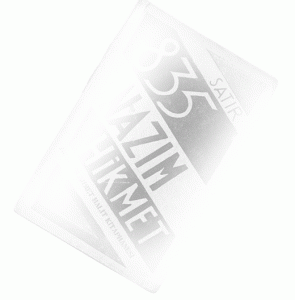On His Poetry
Turgay Fişekçi
 Nâzım Hikmet who was born as the grand child of a pasha in 1902 in Selânik (Salonica- Thessaloniki), was a very lucky child. He grew up in an intellectual ambiance and when he was 15 years old, he met Yahya Kemal Beyatli, a favorite poet of that period, as history teacher in Heybeliada Naval War School . When he was 20 years old, he went to Russia and became a friend of Mayakovsky.
Nâzım Hikmet who was born as the grand child of a pasha in 1902 in Selânik (Salonica- Thessaloniki), was a very lucky child. He grew up in an intellectual ambiance and when he was 15 years old, he met Yahya Kemal Beyatli, a favorite poet of that period, as history teacher in Heybeliada Naval War School . When he was 20 years old, he went to Russia and became a friend of Mayakovsky.
Beside all these, shocking events of his childhood and teenage periods pushed Nâzım to encounter his age’s art and problems.
Even in his first poems written in syllabic meter, he brought expressions which shook ordinary sensitivities and forced the doors of a new, dramatic poem world.
With his poem “Açlarin Gözbebekleri” (The Pupils of The Hungers) he wrote in new style he became acquainted with in Russia, the first free meter (verse) Turkish poem arose.
The years he spent in Moscow were revulotion years for Nâzım Hikmet and his poem. The Futurism and Constructivism trends in poem, the revulotions realized by Stanislavski and Mayerhold in theatre, his deeply learning and understanding a new world view in KUTV (Communist University of Eastern Labourers) where he was educated, totally changed his poem conception. He either tended to innovative form searches and also brought the new contents to poetry.
When he returned to Turkey in 1929, his first poem book ‘835 Satır’ (835 lines) was published consisting of this kind of poems like ‘Makinalasmak’ (To be machined), ‘Salkimsogut’ (Weeping Willow), ‘BahriHazer’(Caspian Sea) and constituted the beginning of a new term in Turkish poetry.
This strong and fully exited voice of Nâzim Hikmet went on his other books published one after another: ‘Jakond ile Si-Ya-U’ (Gioconda And Si-Ya-U, 1929), ‘Varan 3’ (Coming is the 3rd, 1930), 1+1=1 (1930), Sesini Kaybeden Şehir (The City Which Lost its Voice,1931) ‘Benerci Kendini Niçin Öldürdü?’ (Why Did Banarji Kill Himself?,1932), Portreler (Portraits, 1935), ‘Taranta Babu’ya Mektuplar’ (Epistles to Taranta Babu, 1935).
Although these books tried different expression possibilities from each other, their common character is their consisting of high voice, shouting, screaming poems. Beside the unforgettable poems like “Kerem Gibi” (As Kerem), “O Duvar” (That Wall), he performed very strong satire poems written as a response to contemporary polemics, novely realistic expression of a fantastic topic as in Jakond ile Si-Ya-U (Gioconda And Si-Ya-U), and discussion of current revolutionary problems in Banarji.
Another important point of this term’s poems was their strong lyric characteristics despite their shouting voice tones. This lyric characteristic would constitute the main axes of Nâzım Hikmet poem beginning with 1940.
SYNTHESIS OF TRADITION AND INNOVATION
The Seyh Bedreddin Destani (The Epic of Sheik Bedreddin) published in 1936, is an important turning point in Nâzım Hikmet’s poem.
Bedreddin Destani (The Epic of Sheik Bedreddin) appeared as the best product and the resultant of the poet’s all experiments and searches until 1936. He not only made good use of folk and diwan poetry traditions but also constituted new expression possibilities in narrating reformist content by converting them. Although Seyh Bedreddin (Sheik Bedreddin)was a very new work, it made the readers felt also a taste of classic maturity at the same time. The vociferous poet gone, and instead, the ear of a musician who uses the voices in a supremely sensitive way replaced. A realistic painter’s simple color and expression was seen in nature descriptions. Moreover, epic was an example of the perfect harmony to be formed between ideology and art product.
Meanwhile, his poems Karıma Mektup (Letter to My Wife) written in 1933 and Karanlıkta Kar Yağıyor (It’s Snowing in the Dark) written in 1937, are the impressive examples on how the poet will develop.
These two poems realize the magnificent juncture of lirism and realism which was maybe the most important characteristics of Nâzım Hikmet’s poetry.
 Türkçe
Türkçe  ENGLISH
ENGLISH  Español
Español  Русский
Русский 

